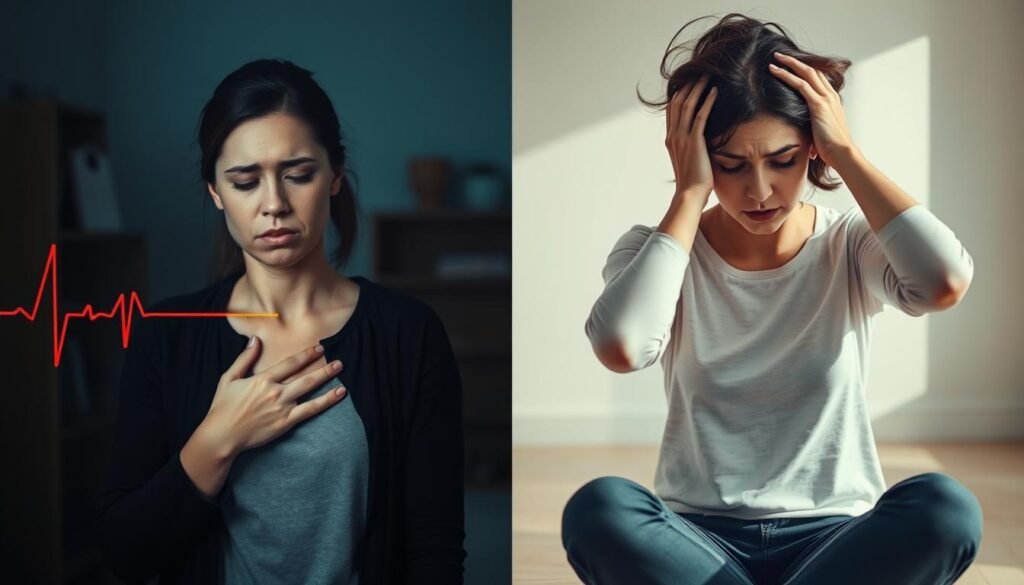About 3% of U.S. adults face panic disorder each year, and many of them are women. This shows how common anxiety disorders are. Yet, it’s vital for women to spot the difference between a heart attack and an anxiety attack. Anxiety in women can show up in many ways. This makes it tough to know when it’s a heart issue.
This piece sheds light on how heart health and anxiety symptoms can be confusing. It’s key to know what signs to check for. Many women have unique symptoms before a heart attack. Understanding these can save lives. It’s crucial for women to know about heart risks and to spot serious signs.
Key Takeaways
- Nearly 3% of U.S. adults experience panic disorder annually.
- Unrecognized symptoms of heart attacks can be similar to anxiety symptoms.
- Women may show different symptoms before a heart attack compared to men.
- Anxiety attacks can last longer and are triggered by specific stressors.
- Recognizing and diagnosing symptoms early can be lifesaving.
Understanding Heart Attacks in Women
Heart attacks show different symptoms, including those unique to women. Knowing these signs is key for quick help. While chest pain and difficulty breathing are well-known, women may face other, less obvious signs.
Common Symptoms of Heart Attack
Heart attacks come with familiar symptoms, such as:
- Chest pain or discomfort
- Shortness of breath
- Nausea or vomiting
- Pain in arms, back, neck, jaw, or stomach
Heart attack symptoms vary in strength and how long they last. This calls for urgent medical care. For some, chest pain is the main sign that stirs fear. However, it’s important for women to know their symptoms could be different. This sometimes causes delays in getting help.
Uncommon Symptoms Unique to Women
Women might have less typical symptoms like:
- Nausea
- Unusual fatigue
- Stress-related discomfort
Women often describe their pain differently, thinking it’s anxiety, not a heart attack. Not having common signs like chest pain may lead to not seeking help soon. This delay might happen because women often link stress with physical issues. Understanding all possible symptoms, including nausea and lasting tiredness, is crucial.
Women need to be proactive about heart health and learn these signs. For more on heart attack symptoms, see this resource.
| Symptoms | Common in Men | Common in Women |
|---|---|---|
| Chest Pain | ✔️ | ✔️ |
| Shortness of Breath | ✔️ | ✔️ |
| Nausea | ❌ | ✔️ |
| Arm Pain | ✔️ | ✔️ |
| Fatigue | ❌ | ✔️ |
Panic Attacks: What You Need to Know
Panic attacks can appear out of nowhere. They bring intense fear and unease. Knowing the symptoms of panic and their causes is vital. People who go through these episodes need this knowledge. Although not deadly, panic attacks greatly affect mental health and daily activities.
Symptoms of Panic Attacks
The symptoms of panic include feelings that seem like serious health issues. They show up in different ways:
- Chest pain or discomfort
- Heart racing, which may reach up to 200 beats per minute
- Trouble breathing
- Sweating and trembling
- Feelings of dizziness or weakness
- Sudden feelings of anxiety and fear
- Difficulty concentrating, often feeling a sense of impending doom
Panic attacks often last from a few minutes to an hour. Recognizing these symptoms helps in managing them. It’s key to know they’re different from heart attacks. This difference can reduce unnecessary worry.
How Panic Attacks Are Triggered
Knowing what starts a panic attack is crucial for stopping them. Emotional stress is a common cause, but there are other factors:
- Significant life changes or stressful events
- Chronic anxiety or worry
- Substance use, including caffeine and alcohol
- Physical health conditions that provoke anxiety symptoms
Understanding these triggers allows people to avoid or handle them better. Many who have panic attacks might have panic disorder. This is an anxiety disorder that needs professional help.
Talking to a healthcare provider is important if symptoms don’t stop. It helps even when you know it’s not a heart attack. Ongoing issues need expert care. For details on telling panic attacks apart from heart issues, check out this resource.
Heart Attack or Anxiety Woman: Key Differences
It’s vital to know the main differences between heart attacks and anxiety attacks. This knowledge can save lives. The difference between heart attack and anxiety is seen in their symptoms and triggers. Knowing these differences helps people understand their health better. This is crucial when they feel unusual or scary symptoms.
Comparing Symptoms
Heart attacks and panic attacks might feel the same, but they’re not. Below is a look at the symptom comparison that shows how they differ:
| Symptom | Heart Attack | Panic Attack |
|---|---|---|
| Chest Pain | Tightness, crushing, or squeezing. Pain often radiates to other areas such as the arm or jaw. | Sharp or stabbing pain, often localized in the chest. |
| Duration | Persistent and does not subside. | Fleeting, usually lasting from a few minutes to about an hour. |
| Other Symptoms | Nausea, cold sweat, lightheadedness, and shortness of breath. | Racing heartbeat, feelings of impending doom, and dizziness. |
Identifying Triggers
The trigger comparison hints at how these conditions start differently. Heart attacks often come after hard work or serious activity, showing a physical cause. Panic attacks, however, can happen out of nowhere. They’re usually tied to emotional or mental stress. Knowing what triggers each can guide what to do if symptoms show up.
The Importance of Recognizing Symptoms
Understanding the symptoms of a potential heart attack is key. This is especially true for women, who might show less common signs. Knowing when to seek help can greatly improve survival rates.
Women over 65 are at the highest risk of dying from heart attacks. By raising awareness and educating, we can encourage early help. This leads to better health outcomes.
Why It’s Critical to Seek Help
Many women underestimate their risk of having a heart attack. They might think chest pain is just anxiety. This delays getting the help they need.
Since women’s symptoms are different from men’s, recognizing them helps in getting timely treatment. Healthcare workers must be careful to properly identify these signs. Quick action can greatly lower the death risk by treating any health issues right away.
Common Misconceptions About Heart Attacks
Many women avoid seeking help quickly because of myths about heart attacks. They wrongly believe heart attacks are a man’s issue. This belief lessens their urgency to get care.
Studies have shown doctors often treat women’s chest pain as anxiety, missing heart problems. Yet, heart disease is a big risk for women too. Things like high blood pressure and diabetes are dangers for everyone and can’t be overlooked.

| Heart Attack Risks | Risk Factors |
|---|---|
| Women | Diabetes, High Blood Pressure, High Cholesterol, Smoking, Family History, Diet High in Saturated Fats |
| Men | Diabetes, High Blood Pressure, High Cholesterol, Smoking, Family History, Diet High in Saturated Fats |
Improving understanding of symptoms and the need for quick help can advance women’s heart health. Expert doctors can tell the difference between anxiety and heart issues. They provide the right care for each person.
How Heart Attacks Behave Over Time
The progression of heart attack symptoms is key in identifying these emergencies. Symptoms vary among people, making recognition crucial. Knowing the symptoms’ duration and variability can save lives.
Duration of Symptoms
Heart attack symptoms last from minutes to hours. They start mild and can get stronger. Health and quick medical help affect the duration. Early signs are important as they show the condition’s seriousness.
Variability of Pain
Heart attack symptoms vary more than those of panic attacks. Panic attacks start suddenly and end quickly. But heart attack discomfort doesn’t fade fast. Chest pain can come and go, changing in strength. This makes it hard to tell apart, highlighting the importance of recognizing heart attack symptoms.
| Symptom Type | Heart Attack | Panic Attack |
|---|---|---|
| Onset | Gradual escalation | Sudden onset |
| Duration | Minutes to hours | Minutes |
| Pain Characteristics | Varied intensity | Consistent intensity |
| Disappearance | Persistent | Typically resolves quickly |
Understanding how heart attack symptoms differ is crucial. This knowledge can quickly lead someone to seek medical care, saving lives.
Understanding Anxiety and Its Effects
Anxiety disorders include various conditions that many adults in the United States face. These disorders often cause confusion with their symptoms. This is because they can look like heart problems caused by anxiety.
Different Types of Anxiety Disorders
There are several anxiety disorders, such as:
- Generalized Anxiety Disorder (GAD) – Affects about 6.8 million adults per year.
- Social Anxiety Disorder – Hits around 12.1% of adults. Yet, over a third wait over ten years to get help.
- Panic Disorder – Known for panic attacks, with symptoms like quickened heartbeats and chest pain.
- Post-Traumatic Stress Disorder (PTSD) – May occur after a traumatic event and can appear much later.
- Obsessive-Compulsive Disorder (OCD) – Features unwanted thoughts and repeated actions.
- Phobias – Such as fear of tight spaces or heights, lead to strong avoidance behaviors.
How Anxiety Can Mimic Heart Problems
The body’s response to anxiety can seem very similar to heart issues. People with anxiety may have symptoms like:
- Chest pain
- Shortness of breath
- An uptick in heart rate
These effects of anxiety can trick people into thinking they have heart problems. Women are especially at risk, being more prone to anxiety disorders than men. It’s also been found that those with anxiety disorders have a 26% higher chance of getting heart disease. Plus, anxiety can negatively impact how well treatments work, making managing both heart and anxiety conditions tougher.

Risk Factors for Heart Attacks in Women
It’s crucial to understand the risk factors for heart attacks in women to better protect their heart health. Studies show that many women have unique symptoms before a heart attack. These symptoms are often missed. Knowing these risk factors helps with early action to prevent heart attacks.
Common Risk Factors to Consider
Women face several key risk factors for heart attacks:
- Age: Women over 55 are more at risk.
- Family History: Your genes can affect heart disease risk.
- Health Status: Conditions like diabetes and obesity increase risk.
- Lifestyle Choices: Smoking, not moving enough, and stress hurt your heart.
Stopping smoking cuts heart disease risk in half in a year. This shows how vital lifestyle changes are to avoid heart risks.
Why Women May Be Underrated in Heart Risks
Women face unique challenges that often go unseen. For example, hormone changes after menopause can up heart attack risk because of lower estrogen levels. Heart disease is the top killer of women. Alarmingly, half of women under 55 don’t realize their risk before having a heart attack.
Women’s heart disease can look different because of their unique body features. Smaller blood vessels and heart chamber walls play a role. Women may have unusual symptoms, making it harder to figure out. Shockingly, almost two-thirds of U.S. women are obese. This greatly increases the risk of heart attacks and artery disease.
| Risk Factor | Impact on Women’s Heart Health |
|---|---|
| Smoking | Three times higher likelihood of a heart attack compared to men. |
| Diabetes | Greatly raises risk, especially with obesity. |
| Obesity | Risk for artery disease jumps 64%. |
| Autoimmune Diseases | Leads to higher heart disease and stroke risk. |
| Psychological Factors | Stress and depression can worsen heart problems. |
By knowing and tackling these risks, women can greatly boost their heart health and overall life quality.
Panic Disorder and Its Prevalence Among Women
Panic disorder has a big impact on women, as many statistics show. It’s important to understand how common this issue is. Since COVID-19, anxiety rates shot up, especially in women.
Statistics on Panic Disorder in Women
About 3.8% of women in the U.S. had panic disorder in the last year, while only 1.6% of men did. This shows that women are more than twice as likely to get anxiety disorders. Around 4.7% of U.S. adults will face panic disorder sometime in their life.
Adolescents aged 13-18 also experience panic disorder. Girls are more affected than boys, with a rate of 2.3%.
The impact of panic disorder varies among adults. Roughly 44.8% deal with serious problems in daily activities. About 29.5% face moderate issues, and 25.7% have mild problems. These figures highlight the need for effective management methods.
Management Options for Panic Disorder
Different treatments can help manage panic disorder. Options include:
- Counseling and therapy for identifying triggers and coping skills
- Medications such as antidepressants and anti-anxiety drugs
- Self-help techniques and lifestyle changes
- Community support programs
Less than 37% of those with anxiety disorders get help. It’s vital for women to ask healthcare providers about treatment. This can improve their health and lower panic disorder rates.

When to Seek Medical Care
Knowing when to spot a heart attack is key to getting help fast. Everyone should learn the major signs that mean you need urgent care. Catching these signs early can save a life.
Red Flags for Heart Attack Symptoms
Heart attack signs shouldn’t be ignored, even if they seem small. Look out for these important warnings:
- Persistent chest pain lasting more than 15 minutes, which may not always present as severe discomfort.
- Shortness of breath that occurs with or without chest pain.
- Pain or discomfort in the neck, back, jaw, arms, or even stomach.
- Nausea and lightheadedness, which may occur more frequently in women than in men.
- Excessive sweating or sudden anxiety that seems out of place.
Know these signs to understand when to get medical help. The American Heart Association has resources on these symptoms. They especially help women, who might have different symptoms than men.
Emergency Responses and Actions
If you see signs of a heart attack, act fast. What you should do:
- Call 911 or local emergency services right away.
- If there’s no access to emergency services, arrange for immediate transportation to the nearest hospital.
- Never ignore even mild symptoms, as their severity can vary vastly from person to person.
Getting help quickly is critical. Hospitals have treatments like clot-busting drugs. They work best in the first hour or two after symptoms start.
Conclusion
Knowing the difference between heart attack and anxiety is key for women. Symptoms like shortness of breath, heartbeats that feel too strong, and chest pain can be confusing. It’s vital to recognize these signs early to improve outcomes.
Women should learn how their heart attack signs might differ, like feeling very tired or sick to their stomach. There are good treatments for anxiety that can also help prevent heart disease. Research shows treating anxiety helps heart health as much as improving your diet or exercise related to heart health.
Being informed and knowing the signs means women can look after their health better. Using techniques to handle anxiety is important for mental and heart health. With lots of people facing anxiety and heart issues, spreading knowledge and awareness is crucial for a healthier life.